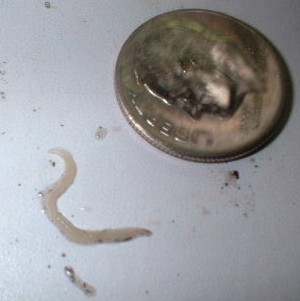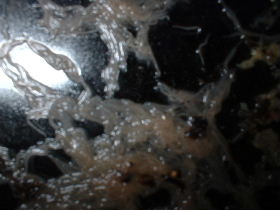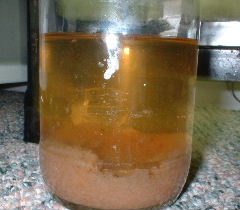| Grindal Worms Obtain a plastic container about a half gallon or a little more. Fill the container with sterile potting soil and peat moss mixed half and half. Moisten the soil but don't soak it. You don't need mud. Add a starter culture of worms and feed them with fish food flakes. Feed a teaspoon a day. |
| Vinegar eels To culture vinegar eels, start with a container such as a 1 gallon jar or similar container with a wide mouth (wide enough to stick your hand through.) an apple, cider vinegar and water. Add a mixture of 50% cider, 50% water and put a hand full of small, peeled apple cubes into the jar. Put half of the starter into the culture and wait about a day to give the bacteria time to get growing, and then put the second half of the starter into the jar. In about a month the culture should be ready for harvesting. Use an eye dropper to collect the worms. You will see them as a cloudy, wriggling mass of worms clinging to the jar at the edge of the cider mixture. |
| White Worms Start with a plywood box or large rubbermaid container, about 16" x 12" x 6" deep, with a close fitting, moisture-resistant top like a sheet of glass, or plastic lid. The box should be filled with moist potting soil, and kept at a temperature of 70F or below. During the summer, they will need to be kept moist and in a cool place, like a garage. Feed them with white bread soaked in milk, or a mixture of old lettuce, fruit, bread crumbs, and oatmeal. Add water and blend it into a very thick soup. Feed a cup of this mixture about once a week. The mixture should be feed in a trench made in the soil. |
Daphnia Links http://www.geocities.com/wonderb3/
|
| The culture should be kept at about 70 F. Put a piece of glass or plastic on the soil and put some food on it. The worms will crawl on top of it and you can harvest them. The worms should be washed off the glass or plastic into a cup of clean water to rinse them off. Use a medicine dropper to suck them up and place them in the tank. Make sure the soil stays moist. |
| Keep the worms in complete darkness. They will
come out of the soil in a big wiggly mass and eat the food quickly. You
can harvest them from the soil. The worms will hide in the soil
whenever a light comes on so you have to be quick collecting them.
Grab the worms and put them in a cup of water to rinse the dirt off of
them. Rinse and pour as many times as it takes to get the worms
fairly clean. To feed place a small bowl in the bottom of the tank. Place worms in the bowl for the fish to eat. If you don't use a bowl the worms will dig into the gravel where the bettas may not find them. |
 |
Pour it through a coffee filter into another cup, and return the liquid to the culture. Many of the eels will pass through the filter, but some will have stuck to it. Pour fresh, clean water though the filter, then turn it inside out and swish the worms into a glass. Now feed them to your fry. When your culture has accumulated lots of muck on the bottom it is time to start a fresh culture. ( It will take several months for it to get mucky) |
 |
 |
| iygyt |
| iygyt |